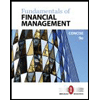
Use of ratios to compare two companies in the same industry
• LO4–10
Presented below are condensed financial statements adapted from those of two actual companies competing in the pharmaceutical industry—Johnson and Johnson (J&J) and Pfizer, Inc. ($ in millions, except per share amounts).
Required:
Evaluate and compare the two companies by responding to the following questions. Note: Because two-year comparative statements are not provided, you should use year-end balances in place of average balances as appropriate.
1. Which of the two companies appears more efficient in collecting its
2. Which of the two firms had greater earnings relative to resources available?
3. Have the two companies achieved their respective
4. From the perspective of a common shareholder, which of the two firms provided a greater rate of return?
5. From the perspective of a common shareholder, which of the two firms appears to be using leverage more effectively to provide a return to shareholders above the rate of return on assets?
Balance Sheets
($ in millions, except per share data)
| J&J | Pfizer | |
| Assets: | ||
| Cash | $ 5,377 | $ 1,520 |
| Short-term investments | 4,146 | 0,432 |
| Accounts receivable (net) | 6,574 | 8,775 |
| Inventories | 3,588 | 5,837 |
| Other current assets | 3,310 | 3,177 |
| Current assets | 22,995 | 29,741 |
| Property, plant, and equipment (net) | 9,846 | 18,287 |
| Intangibles and other assets | 15,422 | 68,747 |
| Total assets | $ 48,263 | $116,775 |
| Liabilities and Shareholders’ Equity: | ||
| Accounts payable | $ 4,966 | $ 2,601 |
| Short-term notes | 1,139 | 8,818 |
| Other current liabilities | 7,343 | 12,238 |
| Current liabilities | 13,448 | 23,657 |
| Long-term debt | 2,955 | 5,755 |
| Other long-term liabilities | 4,991 | 21,986 |
| Total liabilities | 21,394 | 51,398 |
| Capital stock (par and additional paid-in capital) | 3,120 | 67,050 |
| 30,503 | 29,382 | |
| Accumulated other comprehensive income (loss) | (590) | 195 |
| Less: |
(6,164) | (31,250) |
| Total shareholders’ equity | 26,869 | 65,377 |
| Total liabilities and shareholders’ equity | $ 48,263 | $116,775 |
| Income Statements | ||
| Net sales | $ 41,862 | $ 45,188 |
| Cost of goods sold | 12,176 | 9,832 |
| Gross profit | 29,686 | 35,356 |
| Operating expenses | 19,763 | 28,486 |
| Other (income) expense—net | (385) | 3,610 |
| Income before taxes | 10,308 | 3,260 |
| Tax expense | 3,111 | 1,621 |
| Net income | $ 7,197 | $ 1,639* |
| Basic net income per share | $2.42 | $ 0.22 |
* This is before income from discontinued operations.
Want to see the full answer?
Check out a sample textbook solution
Chapter 4 Solutions
INTER. ACCOUNTING - CONNECT+ALEKS ACCESS
- During 2015, the assets of Inspiring Sky increased by $45,000, and the liabilities increased by $20,000. If the owner's equity in Inspiring Sky is $100,000 at the end of 2015, the owner's equity at the beginning of 2015 must have been __. General Accountarrow_forwardDuring 2015, the assets of Inspiring Sky increased by $45,000, and the liabilities increased by $20,000. If the owner's equity in Inspiring Sky is $100,000 at the end of 2015, the owner's equity at the beginning of 2015 must have been __.arrow_forwardCullumber Company uses a job order cost system and applies overhead to production on the basis of direct labor costs. On January 1, 2025, Job 50 was the only job in process. The costs incurred prior to January 1 on this job were as follows: direct materials $16,800, direct labor $10,080, and manufacturing overhead $13,440. As of January 1, Job 49 had been completed at a cost of $75,600 and was part of finished goods inventory. There was a $12,600 balance in the Raw Materials Inventory account on January 1. During the month of January, Cullumber Company began production on Jobs 51 and 52, and completed Jobs 50 and 51. Jobs 49 and 50 were sold on account during the month for $102,480 and $132,720, respectively. The following additional events occurred during the month. 1. Purchased additional raw materials of $75,600 on account. 2. Incurred factory labor costs of $58,800. 3. Incurred manufacturing overhead costs as follows: depreciation expense on equipment $10,080; and various other…arrow_forward
- Determine the amount to be paid in full settlement of each invoice, assuming that credit for returns and allowances was received prior to payment and that all invoices were paid within the discount period. Freight Paid Returns and Merchandise by Seller Freight Terms Allowances a. $9,400 $282 FOB Shipping Point, 1/10, net 30 $900 b. $8,600 $60 FOB Destination, 2/10, net 45 $1,900 a. $ b. $arrow_forwardTravis Company purchased merchandise on account from a supplier for $13,200, terms 2/10, net 30 on December 26. Travis Company paid for the merchandise on December 31, within the discount period. Required: Under a perpetual inventory system, record the journal entries required for the above transactions. Refer to the Chart of Accounts for exact wording of account titles.arrow_forwardCullumber Company uses a job order cost system and applies overhead to production on the basis of direct labor costs. On January 1, 2025, Job 50 was the only job in process. The costs incurred prior to January 1 on this job were as follows: direct materials $16,800, direct labor $10,080, and manufacturing overhead $13,440. As of January 1, Job 49 had been completed at a cost of $75,600 and was part of finished goods inventory. There was a $12,600 balance in the Raw Materials Inventory account on January 1. During the month of January, Cullumber Company began production on Jobs 51 and 52, and completed Jobs 50 and 51. Jobs 49 and 50 were sold on account during the month for $102,480 and $132,720, respectively. The following additional events occurred during the month. 1. Purchased additional raw materials of $75,600 on account. 2. Incurred factory labor costs of $58,800. 3. Incurred manufacturing overhead costs as follows: depreciation expense on equipment $10,080; and various other…arrow_forward
- Cullumber Company uses a job order cost system and applies overhead to production on the basis of direct labor costs. On January 1, 2025, Job 50 was the only job in process. The costs incurred prior to January 1 on this job were as follows: direct materials $16,800, direct labor $10,080, and manufacturing overhead $13,440. As of January 1, Job 49 had been completed at a cost of $75,600 and was part of finished goods inventory. There was a $12,600 balance in the Raw Materials Inventory account on January 1. During the month of January, Cullumber Company began production on Jobs 51 and 52, and completed Jobs 50 and 51. Jobs 49 and 50 were sold on account during the month for $102,480 and $132,720, respectively. The following additional events occurred during the month. 1. Purchased additional raw materials of $75,600 on account. 2. Incurred factory labor costs of $58,800. 3. Incurred manufacturing overhead costs as follows: depreciation expense on equipment $10,080; and various other…arrow_forwardGeneral Accounting questionarrow_forwardWhat Is the correct answer A B ?? General Accounting questionarrow_forward
- Cullumber Company uses a job order cost system and applies overhead to production on the basis of direct labor costs. On January 1, 2025, Job 50 was the only job in process. The costs incurred prior to January 1 on this job were as follows: direct materials $16,800, direct labor $10,080, and manufacturing overhead $13,440. As of January 1, Job 49 had been completed at a cost of $75,600 and was part of finished goods inventory. There was a $12,600 balance in the Raw Materials Inventory account on January 1. During the month of January, Cullumber Company began production on Jobs 51 and 52, and completed Jobs 50 and 51. Jobs 49 and 50 were sold on account during the month for $102,480 and $132,720, respectively. The following additional events occurred during the month. 1. Purchased additional raw materials of $75,600 on account. 2. Incurred factory labor costs of $58,800. 3. Incurred manufacturing overhead costs as follows: depreciation expense on equipment $10,080; and various other…arrow_forwardAccounting questionarrow_forwardNot need ai solution please correct answer general Accountingarrow_forward
 Fundamentals of Financial Management, Concise Edi...FinanceISBN:9781285065137Author:Eugene F. Brigham, Joel F. HoustonPublisher:Cengage Learning
Fundamentals of Financial Management, Concise Edi...FinanceISBN:9781285065137Author:Eugene F. Brigham, Joel F. HoustonPublisher:Cengage Learning Fundamentals of Financial Management, Concise Edi...FinanceISBN:9781305635937Author:Eugene F. Brigham, Joel F. HoustonPublisher:Cengage Learning
Fundamentals of Financial Management, Concise Edi...FinanceISBN:9781305635937Author:Eugene F. Brigham, Joel F. HoustonPublisher:Cengage Learning Financial Accounting: The Impact on Decision Make...AccountingISBN:9781305654174Author:Gary A. Porter, Curtis L. NortonPublisher:Cengage Learning
Financial Accounting: The Impact on Decision Make...AccountingISBN:9781305654174Author:Gary A. Porter, Curtis L. NortonPublisher:Cengage Learning Cornerstones of Financial AccountingAccountingISBN:9781337690881Author:Jay Rich, Jeff JonesPublisher:Cengage LearningCentury 21 Accounting Multicolumn JournalAccountingISBN:9781337679503Author:GilbertsonPublisher:Cengage
Cornerstones of Financial AccountingAccountingISBN:9781337690881Author:Jay Rich, Jeff JonesPublisher:Cengage LearningCentury 21 Accounting Multicolumn JournalAccountingISBN:9781337679503Author:GilbertsonPublisher:Cengage





